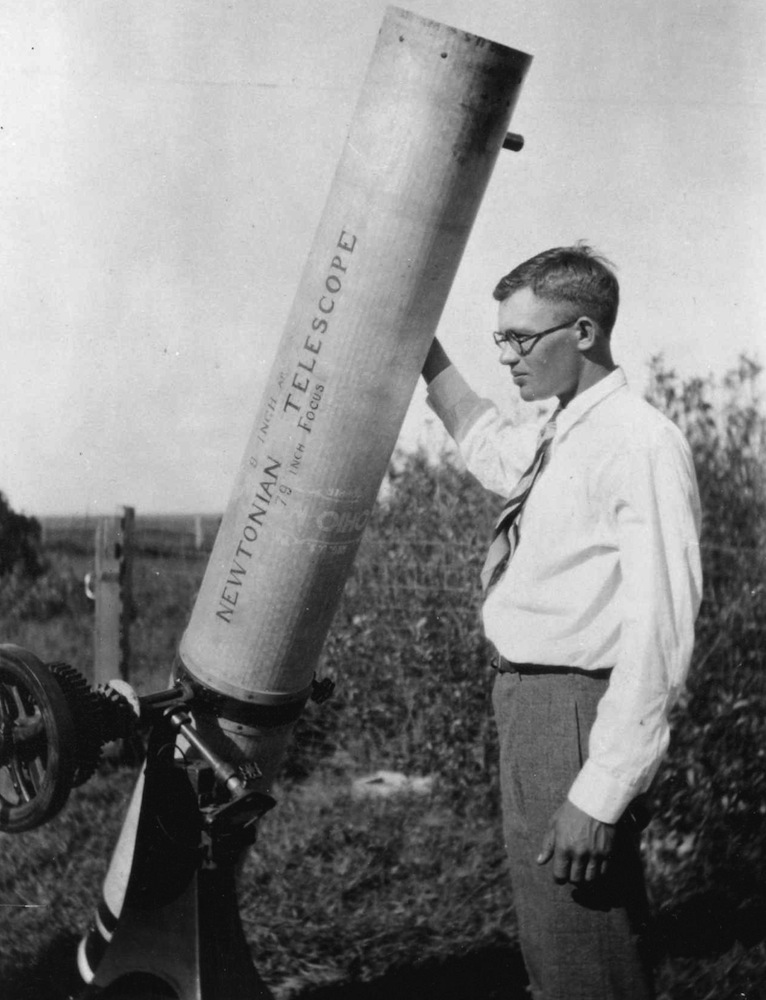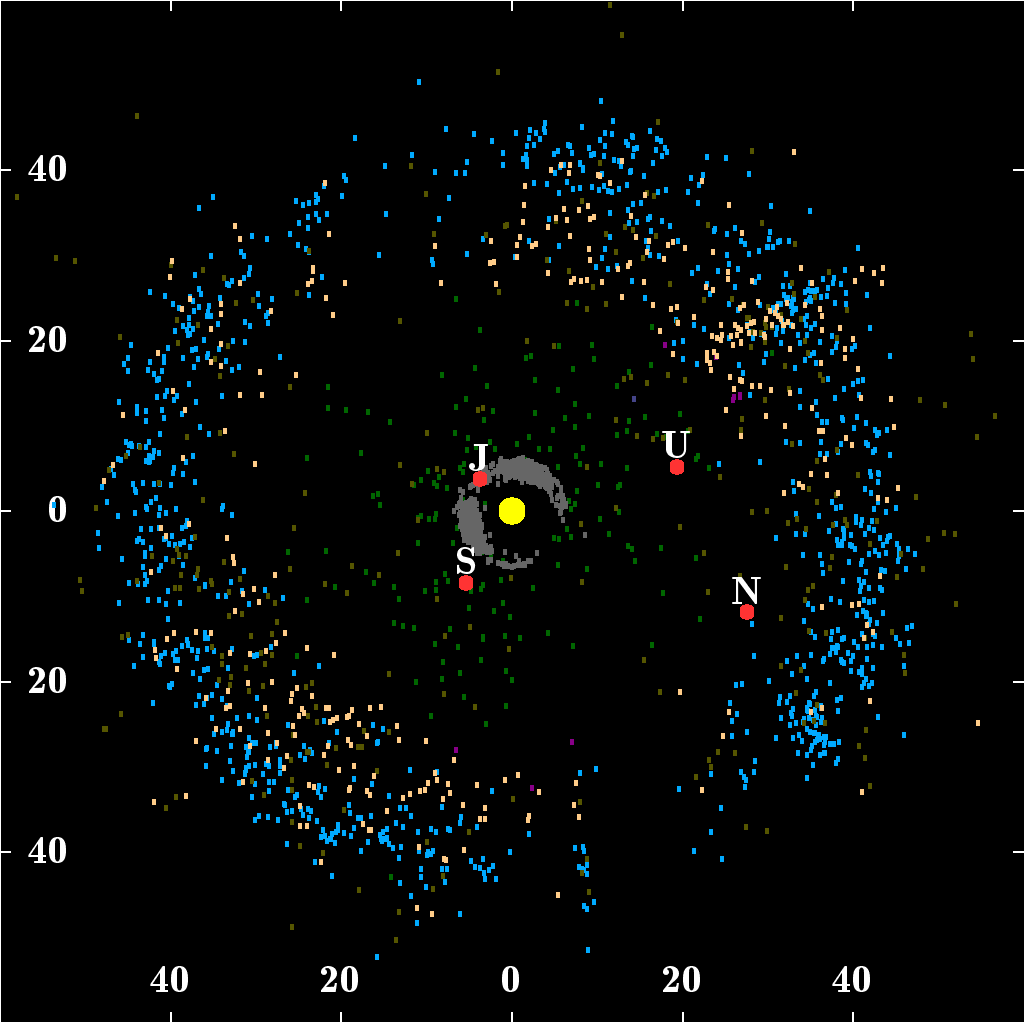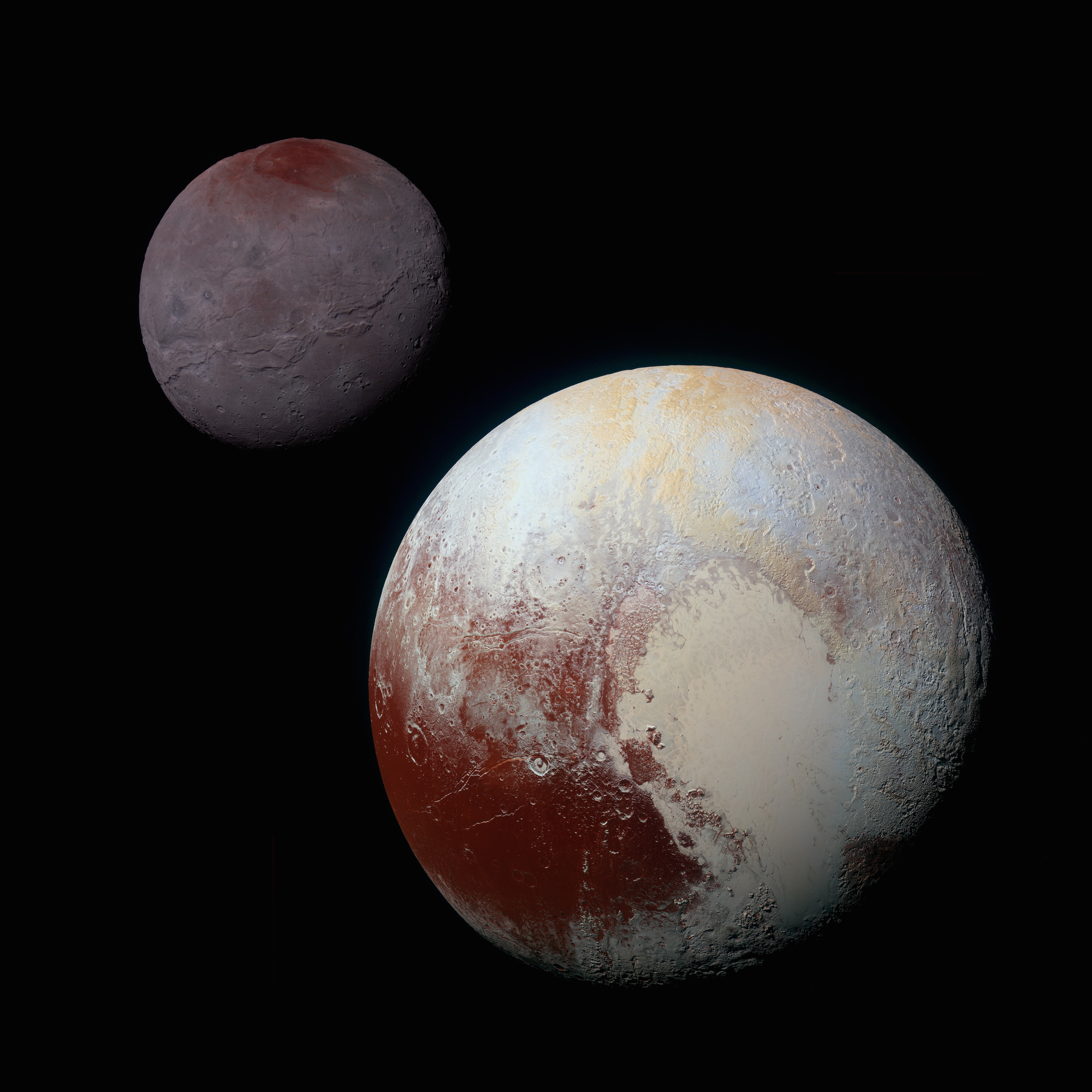|
Plutinos
In astronomy, the plutinos are a dynamical group of trans-Neptunian objects that orbit in 2:3 mean-motion resonance with Neptune. This means that for every two orbits a plutino makes, Neptune orbits three times. The dwarf planet Pluto is the largest member as well as the namesake of this group. The next largest members are , , and . Plutinos are named after mythological creatures associated with the underworld. Plutinos form the inner part of the Kuiper belt and represent about a quarter of the known Kuiper belt objects. They are also the most populous known class of resonant trans-Neptunian objects ''(also see adjunct box with hierarchical listing)''. The first plutino after Pluto itself, (385185) 1993 RO, was discovered on September 16, 1993. Orbits Origin It is thought that the objects that are currently in mean orbital resonances with Neptune initially followed a variety of independent heliocentric paths. As Neptune migrated outward early in the Solar System's histo ... [...More Info...] [...Related Items...] OR: [Wikipedia] [Google] [Baidu] |
Pluto
Pluto (minor-planet designation: 134340 Pluto) is a dwarf planet in the Kuiper belt, a ring of Trans-Neptunian object, bodies beyond the orbit of Neptune. It is the ninth-largest and tenth-most-massive known object to directly orbit the Sun. It is the largest known trans-Neptunian object by volume by a small margin, but is less massive than Eris (dwarf planet), Eris. Like other Kuiper belt objects, Pluto is made primarily of ice and rock and is much smaller than the inner planets. Pluto has roughly one-sixth the mass of the Moon and one-third its volume. Originally considered a planet, its classification was changed when astronomers adopted a new definition of planet, definition of ''planet''. Pluto has a moderately Orbital eccentricity, eccentric and Inclination, inclined orbit, ranging from from the Sun. Light from the Sun takes 5.5 hours to reach Pluto at its orbital distance of . Pluto's eccentric orbit periodically brings it closer to the Sun than Neptune, but a stabl ... [...More Info...] [...Related Items...] OR: [Wikipedia] [Google] [Baidu] |
Classical Kuiper Belt Object
A classical Kuiper belt object, also called a cubewano ( "QB1-o"), is a low-eccentricity Kuiper belt object (KBO) that orbits beyond Neptune and is not controlled by an orbital resonance with Neptune. Cubewanos have orbits with semi-major axes in the 40–50 AU range and, unlike Pluto, do not cross Neptune's orbit. That is, they have low-eccentricity and sometimes low-inclination orbits like the classical planets. The name "cubewano" derives from the first trans-Neptunian object (TNO) found after Pluto and Charon: 15760 Albion, which until January 2018 had only the provisional designation (15760) . Similar objects found later were often called "QB1-os", or "cubewanos", after this object, though the term "classical" is much more frequently used in the scientific literature. Objects identified as cubewanos include: * 15760 Albion (aka and gave rise to term 'Cubewano') * 136472 Makemake, the largest known cubewano and a dwarf planet * 50000 Quaoar and 20000 Varuna, ea ... [...More Info...] [...Related Items...] OR: [Wikipedia] [Google] [Baidu] |
Resonant Trans-Neptunian Object
In astronomy, a resonant trans-Neptunian object is a trans-Neptunian object (TNO) in mean-motion orbital resonance with Neptune. The orbital periods of the resonant objects are in a simple integer relations with the period of Neptune, e.g. 1:2, 2:3, etc. Resonant TNOs can be either part of the main Kuiper belt population, or the more distant scattered disc population. Distribution The diagram illustrates the distribution of the known trans-Neptunian objects. Resonant objects are plotted in red. Orbital resonances with Neptune are marked with vertical bars: 1:1 marks the position of Neptune's orbit and its Neptune trojan, trojans; 2:3 marks the orbit of Pluto and plutinos; and 1:2, 2:5, etc. mark a number of smaller families. The designation ''2:3'' or ''3:2'' both refer to the same resonance for TNOs. There is no ambiguity, because TNOs have, by definition, periods longer than Neptune's. The usage depends on the author and the field of research. Origin Detailed analytical ... [...More Info...] [...Related Items...] OR: [Wikipedia] [Google] [Baidu] |
Kuiper Belt Object
The Kuiper belt ( ) is a circumstellar disc in the outer Solar System, extending from the orbit of Neptune at 30 astronomical units (AU) to approximately 50 AU from the Sun. It is similar to the asteroid belt, but is far larger—20 times as wide and 20–200 times as massive. Like the asteroid belt, it consists mainly of small bodies or remnants from when the Solar System formed. While many asteroids are composed primarily of rock and metal, most Kuiper belt objects are composed largely of frozen volatiles (termed "ices"), such as methane, ammonia, and water. The Kuiper belt is home to most of the objects that astronomers generally accept as dwarf planets: Orcus, Pluto, Haumea, Quaoar, and Makemake. Some of the Solar System's moons, such as Neptune's Triton and Saturn's Phoebe, may have originated in the region. The Kuiper belt is named in honor of the Dutch astronomer Gerard Kuiper, who conjectured the existence of the belt in 1951. There were researchers befo ... [...More Info...] [...Related Items...] OR: [Wikipedia] [Google] [Baidu] |
Kuiper Belt
The Kuiper belt ( ) is a circumstellar disc in the outer Solar System, extending from the orbit of Neptune at 30 astronomical units (AU) to approximately 50 AU from the Sun. It is similar to the asteroid belt, but is far larger—20 times as wide and 20–200 times as massive. Like the asteroid belt, it consists mainly of small Solar System body, small bodies or remnants from when the Formation and evolution of the Solar System, Solar System formed. While many asteroids are composed primarily of rock (geology), rock and metal, most Kuiper belt objects are composed largely of frozen Volatile (astrogeology), volatiles (termed "ices"), such as methane, ammonia, and water. The Kuiper belt is home to most of the objects that astronomers generally accept as dwarf planets: 90482 Orcus, Orcus, Pluto, Haumea, 50000 Quaoar, Quaoar, and Makemake. Some of the Solar System's natural satellite, moons, such as Neptune's Triton (moon), Triton and Saturn's Phoebe (moon), Phoebe, may ha ... [...More Info...] [...Related Items...] OR: [Wikipedia] [Google] [Baidu] |
Cubewano
A classical Kuiper belt object, also called a cubewano ( "QB1-o"), is a low-eccentricity Kuiper belt object (KBO) that orbits beyond Neptune and is not controlled by an orbital resonance with Neptune. Cubewanos have orbits with semi-major axes in the 40–50 AU range and, unlike Pluto, do not cross Neptune's orbit. That is, they have low-eccentricity and sometimes low-inclination orbits like the classical planets. The name "cubewano" derives from the first trans-Neptunian object (TNO) found after Pluto and Charon: 15760 Albion, which until January 2018 had only the provisional designation (15760) . Similar objects found later were often called "QB1-os", or "cubewanos", after this object, though the term "classical" is much more frequently used in the scientific literature. Objects identified as cubewanos include: * 15760 Albion (aka and gave rise to term 'Cubewano') * 136472 Makemake, the largest known cubewano and a dwarf planet * 50000 Quaoar and 20000 Varuna ... [...More Info...] [...Related Items...] OR: [Wikipedia] [Google] [Baidu] |
Neptune
Neptune is the eighth and farthest known planet from the Sun. It is the List of Solar System objects by size, fourth-largest planet in the Solar System by diameter, the third-most-massive planet, and the densest giant planet. It is 17 times the mass of Earth. Compared to Uranus, its neighbouring ice giant, Neptune is slightly smaller, but more massive and denser. Being composed primarily of gases and liquids, it has no well-defined solid surface. Neptune orbits the Sun once every 164.8 julian year (astronomy), years at an orbital distance of . It is named after Neptune (mythology), the Roman god of the sea and has the astronomical symbol representing Trident of Poseidon, Neptune's trident. Neptune is not visible to the unaided eye and is the only planet in the Solar System that was not initially observed by direct empirical observation. Rather, unexpected changes in the orbit of Uranus led Alexis Bouvard to hypothesise that its orbit was subject to gravitational Pe ... [...More Info...] [...Related Items...] OR: [Wikipedia] [Google] [Baidu] |
(385185) 1993 RO
(385185) 1993 RO is a plutino. It was the first plutino discovered after Pluto itself, with 1993 RP and (15788) 1993 SB a day and two days later, respectively. The discovery was made in 1993 at the Mauna Kea Observatory with a 2.2-meter telescope. Very little is known about (385185) 1993 RO. The diameter estimate of ~90 km is based on the assumed albedo of 0.09. Other Kuiper belt objects discovered in 1993 include (15788) 1993 SB, (15789) 1993 SC, and (181708) 1993 FW. See also *List of trans-Neptunian objects *Kuiper belt The Kuiper belt ( ) is a circumstellar disc in the outer Solar System, extending from the orbit of Neptune at 30 astronomical units (AU) to approximately 50 AU from the Sun. It is similar to the asteroid belt, but is far larger—20 times ... References External links IAUC 5865: 1993 RO* 385185 Discoveries by David C. Jewitt Discoveries by Jane Luu 19930914 {{centaurTNO-stub ... [...More Info...] [...Related Items...] OR: [Wikipedia] [Google] [Baidu] |
15810 Arawn
15810 Arawn ( provisional designation ) is a trans-Neptunian object (TNO) from the inner regions of the Kuiper belt, approximately in diameter. It belongs to the plutinos, the most populous class of resonant TNOs. It was named after Arawn, the ruler of the Otherworld in Welsh mythology, and was discovered on 12 May 1994, by astronomers Michael Irwin and Anna Żytkow with the 2.5-metre Isaac Newton Telescope at Roque de los Muchachos Observatory in the Canary Islands, Spain. Arawn is unusual in that it has been observed at a much closer distance than most Kuiper belt objects, by the ''New Horizons'' spacecraft, which imaged it from a distance of in April 2016; this and its other observations have allowed its rotation period to be determined. Orbit and physical properties Arawn is moving in a relatively eccentric orbit entirely beyond the orbit of Neptune. With a semi-major axis of 39.4 AU, it orbits the Sun once every 247 years and 6 months (90,409 days). Its orbit ... [...More Info...] [...Related Items...] OR: [Wikipedia] [Google] [Baidu] |
Monthly Notices Of The Royal Astronomical Society
''Monthly Notices of the Royal Astronomical Society'' (MNRAS) is a peer-reviewed scientific journal in astronomy, astrophysics and related fields. It publishes original research in two formats: papers (of any length) and letters (limited to five pages). MNRAS publishes more articles per year than any other astronomy journal. The learned society journal has been in continuous existence since 1827 and became online only in 2020. It operates as a partnership between the Royal Astronomical Society (RAS), who select and peer-review the contents, and Oxford University Press (OUP), who publish and market the journal. Despite its name, MNRAS is no longer monthly, nor does it carry the notices of the RAS. In 2024 MNRAS became a purely gold open access journal. History The first issue of MNRAS was published on 9 February 1827 as ''Monthly Notices of the Astronomical Society of London'' and it has been in continuous publication ever since. It took its current name from the second vo ... [...More Info...] [...Related Items...] OR: [Wikipedia] [Google] [Baidu] |
Quasi-satellite
A quasi-satellite is an object in a specific type of co-orbital configuration (1:1 orbital resonance) with a planet (or dwarf planet) where the object stays close to that planet over many orbital periods. A quasi-satellite's orbit around the Sun takes the same time as the planet's, but has a different eccentricity (usually greater), as shown in the diagram. When viewed from the perspective of the planet by an observer facing the Sun, the quasi-satellite will appear to travel in an oblong retrograde loop around the planet. . In contrast to ''true'' satellites, quasi-satellite orbits lie outside the planet's Hill sphere, and are unstable. Over time they tend to evolve to other types of resonant motion, where they no longer remain in the planet's neighborhood, then possibly later move back to a quasi-satellite orbit, etc. Other types of orbit in a 1:1 resonance with the planet include horseshoe orbits and tadpole orbits around the Lagrangian points, but objects in these orbits do no ... [...More Info...] [...Related Items...] OR: [Wikipedia] [Google] [Baidu] |






